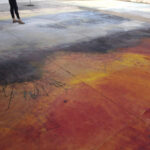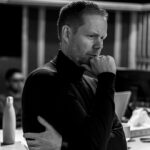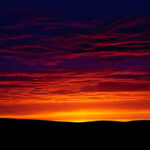Museum of the Moon
Museum of the Moon is a touring artwork by UK artist Luke Jerram.
Measuring seven metres in diameter, the moon features 120dpi detailed NASA imagery of the lunar surface. At an approximate scale of 1:500,000, each centimetre of the internally lit spherical sculpture represents 5km of the moon’s surface.
Over its lifetime, the Museum of the Moon will be presented in a number of different ways both indoors and outdoors, so altering the experience and interpretation of the artwork. As it travels from place to place, it will gather new musical compositions and an ongoing collection of personal responses, stories and mythologies, as well as highlighting the latest moon science.
The installation is a fusion of lunar imagery, moonlight and surround sound composition created by BAFTA and Ivor Novello award-winning composer Dan Jones. Each venue also programmes their own series lunar-inspired events beneath the moon.
Luke Jerram’s multidisciplinary practice involves the creation of sculptures, installations and live arts projects. Living in the UK but working internationally for 19 years, Jerram has created a number of extraordinary art projects which have excited and inspired people around the globe. Jerram has a set of different narratives that make up his practice which are developing in parallel with one another. He is known worldwide for his large scale public artworks.
FAQ – Frequency Asked Questions
1. Where did you get the idea to make an artwork such as Museum of the Moon?
Bristol has the highest tidal range in Europe. There’s a 13m gap between high tide and low tide. Cycling to work each day over the river to work, reminded me that it’s the gravitational pull of the Moon that’s making this happen. I had the idea to create the Museum of the Moon some 15 years ago, but it was only until very recently that the data for creating the Moon imagery was made available by NASA.
As a child I always wanted a telescope so I could study the Moon and the night’s sky. Now with my own Moon, I can fly there, study every detail and share this experience with the public. We can explore the far side of the Moon which is never visible from Earth.
2. The moon has always been an inspiration for artists. What was so inspiring for you about the moon?
From the beginning of human history, the moon has acted as a ‘cultural mirror’ to our beliefs, understanding and ways of seeing. Over the centuries, the moon has been interpreted as a god and as a planet. It has been used as a timekeeper, calendar and to aid night time navigation. Throughout history the moon has inspired artists, poets, scientists, writers and musicians the world over. The ethereal blue light cast by a full moon, the delicate crescent following the setting sun, or the mysterious dark side of the moon has evoked passion and exploration. Different cultures around the world have their own historical, cultural, scientific and religious relationships to the moon.
Museum of the Moon allows us to observe and contemplate cultural similarities and differences around the world, and consider the latest moon science. Depending on where the artwork is presented, its meaning and interpretation will shift. Through local research at each location of the artwork, new stories and meanings will be collected and compared from one presentation to the next.
3. During its tour, the Moon has always be shown in public spaces. Why is it important to you to show your artworks in public spaces?
Depending on where the artwork is presented, the meaning and interpretation of the Museum of the Moon, will shift. The interpretation of the Moon will be completely different if it is presented in a cathedral, warehouse, science museum or arts centre.
Whether the artwork is exhibited in China, USA, India or Europe the cultural context and audience, also effects the public’s interpretation. Every culture has its own relationship to the Moon which varies from one country to another.
4. Museum of the Moon is made of really precise lunar imagery from NASA. Can you explain this choice?
I wanted to make the artwork seem as authentic and realistic as possible. For most people, this will be their most intimate, personal and closest encounter they will ever have with the Moon.
5. What’s been the public’s response?
It’s been wonderful to witness the publics’ response to the artwork. Many people spend hours with the Moon exploring its every detail. Some visitors lie down and moon-bathe.
At our exhibition Natural History Museum a man in a suit came up to me in tears. He explained how he was a space scientist from the European Space Agency and had spent his career studying the surface of the moon. I gave him a hug and he left the exhibition, a very happy man!
In Leicester one young girl asked “will you put the moon back afterwards?” She thought I’d stolen the real moon! I reassured the young girl that I would definitely return the moon after the exhibition.
In Bristol, we had an unexpected group of visitors who arrived in slow motion to the exhibition, dressed as spacemen!
In Marseille I arranged an arc of deckchair beneath the Moon. Within minutes, many of the chairs had been groups into pairs and were occupied by couples holding hands!
6. Why has the artwork been so well received?
I think one of the reasons the artwork has been well received so far, is that it leaves space for the public to interact with one another and participate in a communal shared experience. The artwork can be accessed an enjoyed by different people at different levels. It can be enjoyed as much by a 4 year old child as much as a professional astronomer.
To date over 3million people have visited the artwork. We often draw massive crowds many of which will have never have visited the museum or gallery before.
The Museum of the Moon is both an installation artwork, as well as a venue for other people to be creative. Hosts programme their own lunar inspired events to take place beneath the Moon. This way the artwork can reflect the culture and community of a venue.
7. Each venue that hosted the Moon had its own architectural specificities. It also offered different performances beneath the Moon. Therefore it is always a new story. Why is it important to you to have several performances going on beneath your Moon?
Like many of my artworks like Play Me, I’m Yours and Withdrawn, this work provides opportunities for collaboration and the creative input of others.
The Museum of the Moon is an installation artwork that combines the architecture of the space, the sculpture of the Moon and a surround sound composition. Each venue and host, has the opportunity to curate their own moon-inspired events which reflect their local culture and creativity.
8. Music is also very important for your artwork. How relevant and important is Dan Jones’ composition to your work?
The Museum of the Moon installation is a fusion of lunar imagery, moonlight and surround sound composition. I’ve worked with Dan over 15 years, commissioning him to create music for a number of my art installations. We both understand the power that music has to paint imagery in our imaginations.
For the Museum of the Moon, the surround sound composition helps connect the sculpture of the moon with the surrounding architecture. For me, the music in the spacel shapes the atmosphere of the experience guides the interpretation of the artwork.
9. How long did the artwork take to make?
The artwork took 6 months to make. There was a lot of prototyping, planning and fundraising. The artwork was commissioned by many partners coming together to support the initial creation.
I originally had the idea to make this accurate facsimile of the moon 15 years ago. But back then neither the data nor the printing technology were available.
More information about the artwork can be found at:


 Max Richter stands as one of the most prodigious figures on the contemporary music scene, with ground-breaking work as a composer, pianist, producer, and collaborator. From synthesizers and computers to a full symphony orchestra, Richter’s innovative work encompasses solo albums, ballets, concert hall performances, film and television series, video art installations and theatre works. He is Classically trained, studying at Edinburgh University, the Royal Academy of Music, London, and completing his studies with composer Luciano Berio in Florence,
Max Richter stands as one of the most prodigious figures on the contemporary music scene, with ground-breaking work as a composer, pianist, producer, and collaborator. From synthesizers and computers to a full symphony orchestra, Richter’s innovative work encompasses solo albums, ballets, concert hall performances, film and television series, video art installations and theatre works. He is Classically trained, studying at Edinburgh University, the Royal Academy of Music, London, and completing his studies with composer Luciano Berio in Florence, K
K
 Described as a violinist with ‘chops to burn, and rock solid musicianship’ (The Whole Note, TORONTO), Canadian violinist Véronique Mathieu enjoys an exciting career as a soloist, chamber musician, and music educator. Recent engagements have taken her throughout Europe and Asia, and she continues to work extensively with composers. Her CD ARGOT was recently featured on a BBC series dedicated to the music of Lutoslawski, and receives frequent airplay in the US. Recent highlights include the Canadian premiere of Marc-André Dalbavie’s violin concerto with Esprit Orchestra, a performance of John Corigliano’s Chaconne during the composer’s 80th birthday celebrations, the release of a second CD with pianist Stephanie Chua, and numerous recitals throughout North America.
Described as a violinist with ‘chops to burn, and rock solid musicianship’ (The Whole Note, TORONTO), Canadian violinist Véronique Mathieu enjoys an exciting career as a soloist, chamber musician, and music educator. Recent engagements have taken her throughout Europe and Asia, and she continues to work extensively with composers. Her CD ARGOT was recently featured on a BBC series dedicated to the music of Lutoslawski, and receives frequent airplay in the US. Recent highlights include the Canadian premiere of Marc-André Dalbavie’s violin concerto with Esprit Orchestra, a performance of John Corigliano’s Chaconne during the composer’s 80th birthday celebrations, the release of a second CD with pianist Stephanie Chua, and numerous recitals throughout North America.


